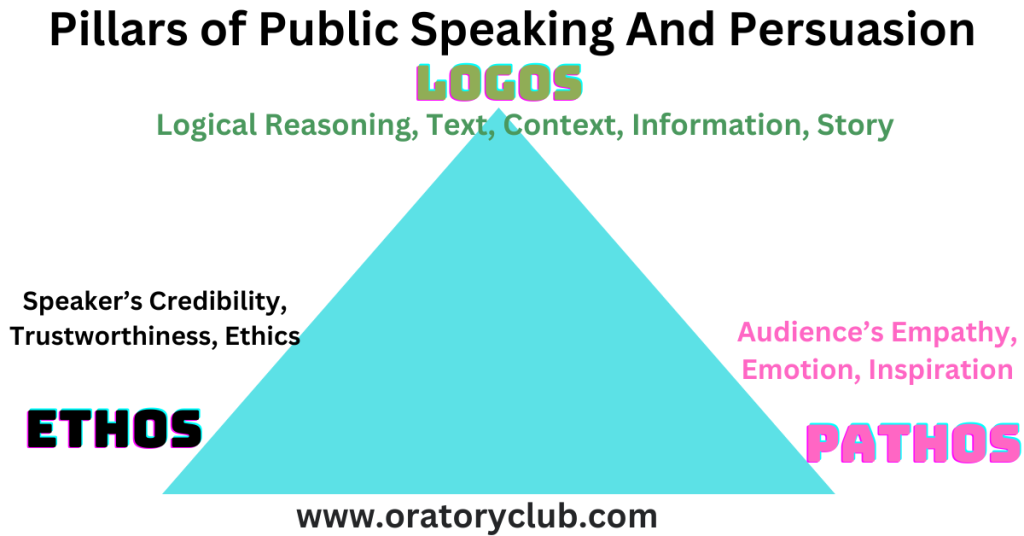Ethos, Pathos, Logos: 3 Pillars of Public Speaking And Persuasion
Ethos, pathos, and logos are the three pillars of public speaking and persuasion. In public speaking and persuasion, ethos refers to the speaker’s credibility, pathos appeals to the audience’s emotions, and logos employs logical reasoning and evidence.
Aristotle taught that a speaker’s ability to persuade an audience is based on how well the speaker appeals to that audience in three different areas: logos, ethos, and pathos. The rhetoricians have called it the rhetorical triangle.
These three elements play a crucial role in communicating effectively and persuasively, enabling speakers to establish credibility, elicit emotional response, and deliver a strong logical argument. By understanding and incorporating these elements, speakers can enhance their persuasive abilities and engage their audience on a deeper level, ultimately achieving their desired outcomes.

The Power Of Ethos In Public Speaking And Persuasion
Discover the undeniable influence of ethos in public speaking and persuasion. Explore the three pillars of effective communication – ethos, pathos, and logos – to master the art of compelling speeches and persuasive arguments. Unleash the power of ethos for greater influence and impact.
Definition And Explanation Of Ethos
Ethos in public speaking is the persuasive appeal rooted in the speaker’s credibility and ethical character. It establishes trust, showcasing the speaker’s expertise, integrity, and authority on the subject. Ethos captivates the audience by fostering belief in the speaker’s sincerity, knowledge, and commitment, enhancing the overall persuasiveness of the message.
- Ethos refers to the persuasive appeal of credibility, trustworthiness, and ethical character used by a speaker to influence their audience.
- It involves establishing oneself as a knowledgeable, reliable, and trustworthy source of information.
- By utilizing ethos, speakers aim to gain the audience’s respect and convince them of their expertise on the topic at hand.
How Ethos Establishes Credibility And Trustworthiness
- Demonstrating expertise: Utilizing ethos involves showcasing extensive knowledge and expertise in the subject matter, enabling the speaker to establish themselves as a credible source of information.
- Establishing qualifications: By highlighting relevant qualifications, such as degrees, certifications, or practical experience, speakers can enhance their credibility and portray themselves as trustworthy authorities.
- Sharing personal experiences: By relating personal experiences or stories that align with the topic, speakers can effectively establish a connection with the audience and build trust.
The Role Of Ethos In Building Rapport With The Audience
- Establishing common ground: Ethos plays a crucial role in helping speakers connect with their audience by finding shared beliefs, experiences, or values. This shared understanding builds rapport and allows for a deeper connection throughout the speech.
- Demonstrating empathy: By displaying empathy towards the audience’s concerns, emotions, or experiences, speakers can establish a sense of connection and foster trust.
- Displaying authenticity: Ethos is also linked to authenticity. Speakers who are genuine, passionate, and honest about their intentions can easily engage and build rapport with the audience.
Examples Of Using Ethos Effectively In Speeches
- Expert endorsements: Citing reputable experts or organizations within the field can lend credibility and influence to the speaker’s argument.
- Personal anecdotes: Sharing personal stories or experiences related to the topic can establish a sense of authenticity and relatability.
- Providing evidence: Backing up statements with reliable data, research, or statistics helps to establish the speaker’s credibility and enhances their ethos.
- Referring to one’s professional experience: Relating real-life examples from one’s own professional journey can establish authority, enhancing the speaker’s persuasiveness.
Ethos is a vital tool in the art of public speaking and persuasion. By focusing on establishing credibility, trustworthiness, and building rapport with the audience, speakers can effectively influence and persuade their listeners.
Mastering The Art Of Pathos For Effective Persuasion
Master the art of pathos to enhance your persuasion skills and learn how to effectively utilize pathos in your communication. Pathos is especially effective when combined with ethos and logos, as it can help create a well-rounded persuasive argument. By connecting with the audience on an emotional level, speakers can evoke empathy, and sympathy, or even inspire action.
Defining Pathos And Its Emotional Appeal
Pathos in public speaking is the emotional appeal that connects the speaker and the audience. It taps into listeners’ emotions, creating a shared experience and fostering empathy. Through poignant stories, vivid language, or heartfelt gestures, speakers evoke feelings, making their message resonate deeply. Pathos transcends logic, forging a powerful connection that lingers in the hearts of the audience.
How To Evoke Emotions In The Audience Through Storytelling
- Engage the audience: Begin your speech with an attention-grabbing story that relates to the topic at hand. This will captivate the audience and make them more receptive to your message.
- Use personal anecdotes: Share personal experiences that evoke emotions related to the topic. By demonstrating your own emotional connection, you can encourage the audience to empathize and connect with your message.
- Appeal to values: Highlight universal values that the audience can relate to. By emphasizing shared beliefs and values, you can tap into the emotions of the audience and inspire them to take action.
- Show vulnerability: Sharing moments of vulnerability can create a deeper emotional connection with the audience. By being open and authentic, you can elicit empathy and make your message more powerful.
Creating Emotional Connections
- Choose impactful words: Select words that are powerful and evoke strong emotions. Use descriptive language to paint a vivid picture in the audience’s minds.
- Paint visual imagery: Use storytelling techniques to describe scenes or situations that evoke emotions. By appealing to the audience’s imagination, you can create a lasting emotional impact.
- Utilize metaphors and similes: Metaphors and similes can help convey complex emotions in a concise and relatable manner. Compare abstract concepts to familiar objects or situations to make your message more accessible and emotionally resonant.
- Incorporate sensory details: Engage all the senses by incorporating sensory details into your speech. By appealing to sight, sound, taste, smell, and touch, you can create a multisensory experience that enhances the emotional connection with the audience.
Case Studies On Successful Use Of Pathos In Persuasive Communications
- Martin Luther King “I Have a dream” speech: Through his powerful use of emotional language and vivid imagery, King evoked strong emotions of hope and justice, inspiring a generation to fight for civil rights.
- Apple’s “1984” commercial: By tapping into the audience’s emotions of rebellion and empowerment, this iconic commercial showcased Apple’s innovative spirit and generated excitement for its products.
- Malala Yousafzai’s United Nations speech: Yousafzai shared her personal story of resilience and bravery, connecting emotionally with the audience and inspiring action in support of girls’ education.
- Charity campaigns featuring heart-wrenching stories of individuals in need: By sharing personal stories and creating emotional connections, these campaigns successfully motivate people to donate and support charitable causes.
By mastering the art of pathos, speakers can effectively appeal to the emotions of their audience, creating a deeper connection and increasing the power of their persuasive communication. Remember, a powerful story, impactful language, and relatable experiences are key to evoking emotions and making a lasting impact through pathos.
Utilizing Logos To Strengthen Persuasive Arguments
Logos is a powerful tool that strengthens persuasive arguments by utilizing logic and reason. It forms one of the three pillars, alongside ethos and pathos, which are crucial for effective public speaking and persuasion. By appealing to the audience’s rationality, logos helps to make a convincing case and gain trust.
Logos in public speaking refers to the persuasive appeal based on logic and reasoning. It involves presenting clear, factual evidence, statistical data, and rational arguments to support a speaker’s position. Logos strengthens the credibility of the message, providing the audience with a logical foundation to understand and accept the speaker’s perspective.
The Significance Of Logos In Logical Reasoning
- Logos, the Greek term for logic, is a critical element in public speaking and persuasion. It appeals to the audience’s intellect and reinforces arguments with sound reasoning and evidence. Here are the key aspects of logos in persuasive communication:
Incorporating facts, statistics, and research to support arguments:
- Facts, statistics, and research findings serve as the foundation for a strong logical argument. By including empirical evidence, speakers can demonstrate credibility and build trust with their audience. Some effective ways to incorporate these elements are:
- Ensure that the data and information come from reliable sources.
- Use recent and up-to-date research to enhance the relevance of the argument.
- Clearly reference the sources, providing credibility to the information presented.
- Utilize data visualization techniques to make complex statistics more accessible and easily understandable to the audience.
Effective use of logical structure and organization in speeches:
- A logical and well-structured speech is vital in keeping the audience engaged and understanding the message. By following a coherent structure, speakers can present their arguments in a clear and easy-to-follow manner. Here are some tips for employing logical structure and organization:
- Start with an introduction that clearly states the purpose of the speech and introduces the main arguments.
- Develop each argument with supporting evidence and examples, ensuring a logical flow between ideas.
- Use transitional phrases and signposts to guide the audience through the speech.
- Summarize and restate key points in the conclusion to reinforce the main message.
Tips for appealing to the audience’s intellect through logos:
- To effectively engage the audience’s intellect and make persuasive arguments, speakers need to consider the following strategies:
- Understand the audience: Tailor the arguments to resonate with the audience’s interests, values, and knowledge level.
- Use logical reasoning: Clearly articulate the cause-and-effect relationships and logical connections between ideas to enhance the persuasiveness of the argument.
- Anticipate counterarguments: Address potential counterarguments and provide logical refutations to strengthen the overall position.
- Use comparative analysis: Compare and contrast different ideas or perspectives, using logical reasoning and evidence to support the preferred option.
By utilizing logos in public speaking, speakers can craft persuasive arguments that are backed by evidence, logic, and a well-structured approach. It enhances the audience’s understanding and credibility, increasing the overall persuasive impact of the speech.
Balancing Ethos, Pathos, And Logos For Maximum Persuasive Impact

Credit: virtualspeech.com
Achieve maximum persuasive impact by balancing ethos, pathos, and logos — the three pillars of public speaking and persuasion. Harness the power of credibility, emotion, and logical reasoning for effective communication and influencing others.
Understanding The Interplay Between Ethos, Pathos, And Logos
Ethos, pathos, and logos are the three pillars of public speaking and persuasion. Each of these rhetorical devices plays a crucial role in building a compelling argument.
- Ethos: Establish credibility; convince the audience of the speaker’s trustworthiness.
- Pathos: Evoke emotions; stir audience feelings for persuasive impact.
- Logos: Appeal to logic; present reasoned arguments for audience persuasion.
Understanding how these three pillars work together is essential for effective persuasion. By striking the right balance between ethos, pathos, and logos, speakers can maximize their persuasive impact and engage the audience on multiple levels.
Strategies For Combining All Three Pillars Effectively
By combining ethos, pathos, and logos strategically, you can enhance your persuasive abilities and effectively engage your audience. To leverage the power of ethos, pathos, and logos, here are some strategies you can employ:
- Begin with ethos: Start by establishing your credibility and expertise on the topic. Share relevant credentials and demonstrate your knowledge to gain the audience’s trust right from the start.
- Appeal to emotions strategically: Incorporate pathos by appealing to emotions, weaving relatable stories into your speech. Engage the audience’s empathy, making your message more memorable and impactful. Convey passion and sincerity to establish a genuine connection.
- Present evidence and reasoning: Simultaneously, infuse logos into your speech by presenting logical, well-reasoned arguments. Use data, evidence, and clear reasoning to support your points. Structure your speech coherently, guiding the audience through a logical flow of ideas.
- Use rhetorical devices effectively: Employ rhetorical techniques such as repetition, parallel structure, and rhetorical questions to make your speech more memorable and persuasive.
- Maintain a balanced approach: While all three pillars are important, make sure none overshadows the others. Strive for equilibrium, allowing each element to complement the others rather than overshadowing them. Strike a balance between the three pillars, ensuring that your credibility, emotional appeal, and logical reasoning complement each other.
- Consistency is key: Align your emotional stories with the overall logic of your argument, reinforcing your ethos throughout. By harmonizing ethos, pathos, and logos, you create a persuasive, well-rounded speech that resonates with your audience on multiple levels, fostering a lasting impact.
The Importance Of Adapting To Different Audiences And Contexts
No two audiences or contexts are alike, and what works for one may not work for another. Adapting your persuasive approach to suit different audiences and contexts is crucial for effective communication. Here’s why:
- Understanding audience demographics: Analyze your audience’s demographics, including age, gender, cultural background, and education level. Tailor your message to align with their values, preferences, and experiences.
- Researching the context: Consider the specific context in which you are speaking, such as a formal conference, a casual meeting, or an online platform. Adjust your style, tone, and language accordingly to resonate with the audience.
- Adapting the content: Modify your arguments, examples, and evidence to be relevant and relatable to the particular audience. Ensure that your message addresses their concerns and speaks directly to their needs.
- Considering previous knowledge: Assess the audience’s prior knowledge and familiarity with the topic. Avoid using jargon or complex terminology that may alienate or confuse them. Instead, strive for clarity and simplicity in your message.
- Engaging with feedback: Pay attention to audience reactions and feedback. Be open to adjusting your approach on the fly, based on their responses. Building a rapport and fostering a sense of collaboration can enhance persuasive impact.
By adapting to different audiences and contexts, you can connect with people more effectively and increase the chances of successful persuasion.
Real-Life Examples Of Successful Persuasion Campaigns
Looking at real-life examples of successful persuasion campaigns can provide valuable insights into how ethos, pathos, and logos can be utilized effectively. Here are a few noteworthy examples:
- Apple’s “Think Different” Campaign: Apple’s iconic campaign appealed to pathos by celebrating individuals who challenged the status quo. It evoked emotions and inspired audiences to believe in their potential for greatness.
- Dove’s “Real Beauty” Campaign: Dove’s campaign appealed to pathos by challenging conventional beauty standards. By using real women in their advertisements and promoting self-acceptance, dove resonated with audiences on an emotional level.
- Barack Obama’s 2008 Presidential Campaign Speeches: Obama’s speeches incorporated ethos by leveraging his personal story and expertise as a community organizer. He also appealed to pathos through emotive language and an inspiring vision for change.
- The “Friends don’t let friends drive drunk” campaign: This anti-drunk driving campaign utilized logos by presenting statistical evidence of the dangers of drunk driving. It appealed to logic, backed by factual data on the consequences of such behavior.
These examples demonstrate how a strategic combination of ethos, pathos, and logos can effectively persuade audiences and bring about positive change. By studying successful campaigns, you can gain valuable insights on how to tailor your persuasive approach.
Elevating Your Public Speaking And Persuasion Skills
Public speaking and persuasion are vital skills in many aspects of life. Whether you’re giving a presentation at work or trying to convince someone of your point of view, being able to effectively communicate your ideas is crucial. Ethos, pathos, and logos are three pillars that can elevate your public speaking and persuasion skills.
Let’s explore how to improve your delivery and body language, practice effective storytelling techniques, develop strong argumentation skills, and apply ethos, pathos, and logos in everyday communication.
Improving Your Delivery And Body Language:
- Maintain eye contact with your audience: Engaging with your audience through eye contact helps build a connection and establishes credibility.
- Use appropriate gestures: Use hand movements and body language to emphasize key points and make your presentation more engaging.
- Speak with confidence and clarity: Project your voice, enunciate your words, and maintain a steady pace to ensure your message is effectively conveyed.
- Practice active listening: Pay attention to your audience’s reactions and adjust your delivery accordingly to keep them engaged.
Practicing Effective Storytelling Techniques:
- Start with a compelling hook: Begin your speech or presentation with a captivating story or anecdote to grab the audience’s attention.
- Create structure: Organize your content in a logical and coherent manner, using clear transitions to guide your audience through your narrative.
- Use vivid language and imagery: Paint a picture with your words to help your audience visualize and connect emotionally with your story.
- Incorporate personal experiences: Sharing personal stories can make your message relatable and help build a connection with your audience.
Developing Strong Argumentation Skills:
- Research your topic thoroughly: Gather relevant data, facts, and examples to support your arguments and make your case more persuasive.
- Anticipate counterarguments: Consider opposing viewpoints and address them proactively to strengthen your position.
- Use logical reasoning: Present your arguments in a logical sequence, using cause-and-effect relationships or supporting evidence to substantiate your claims.
- Be concise and focused: Clearly articulate your main points and avoid rambling or going off-topic, as it can diminish the impact of your arguments.
Frequently Asked Questions
What Are The Three Pillars Of Public Speaking?
The three pillars of public speaking are ethos, pathos, and logos. Ethos refers to the credibility of the speaker, pathos appeals to the emotions of the audience, and logos relies on logical reasoning and evidence to persuade.
How Does Ethos Contribute To Effective Public Speaking?
Ethos plays a crucial role in effective public speaking by establishing the speaker’s credibility and trustworthiness. When a speaker is perceived as credible, the audience is more likely to be convinced and persuaded by their arguments and ideas.
Why Is Pathos Important In Public Speaking?
Pathos is important in public speaking as it appeals to the emotions of the audience. By evoking emotions such as empathy, happiness, or anger, a speaker can create a stronger connection with the audience and make their message more memorable and impactful.
How Does Logos Strengthen A Persuasive Speech?
Logos strengthens a persuasive speech by relying on logical reasoning, evidence, and facts. This helps to support the speaker’s arguments and make them more convincing to the audience. Logically sound arguments can also counter opposing viewpoints and strengthen the overall persuasive impact of the speech.
Conclusion
Mastering the art of public speaking and persuasion requires the effective use of ethos, pathos, and logos. By establishing credibility, appealing to emotions, and presenting logical arguments, speakers can capture the attention of their audience, evoke powerful feelings, and compel them to action.
Ethos allows speakers to build trust and credibility by showcasing their knowledge, experience, and integrity. Pathos taps into the emotions of the audience, connecting with them on a deeper level and making the message more relatable and memorable. Lastly, logos involves presenting facts, evidence, and logical reasoning to support the speaker’s argument and persuade the audience through rational thinking.
By incorporating these three pillars into their public speaking, individuals can become influential communicators who are capable of making a lasting impact on their audience. So, whether you are presenting in front of a large crowd or having a one-on-one conversation, remember to embrace ethos, pathos, and logos to captivate attention, inspire emotions, and deliver a persuasive message.


